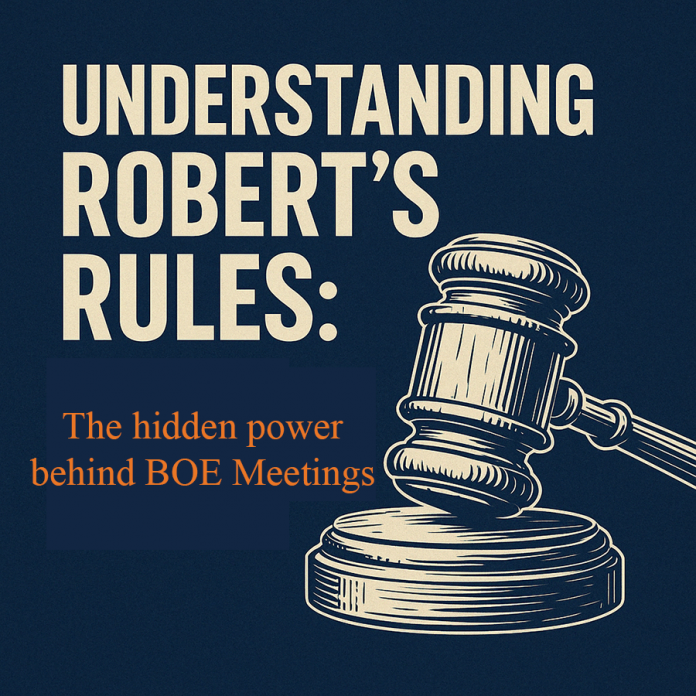For many residents, watching an East Brunswick Board of Education meeting can feel like watching a game where you’re not sure of the rules, and that’s not just a metaphor. The rules do exist. They’re detailed. They’re formal. And most of the time, they’re invisible to the average person.
Those rules are called Robert’s Rules of Order and are the foundation for how BOE meetings are supposed to function across New Jersey and here in East Brunswick. But what happens when only a few board members truly understand them?
Let’s break it down.
What Are Robert’s Rules of Order, and Why Do They Matter?
Robert’s Rules of Order is a formal guide for running public meetings. It outlines who can speak, when, how motions are introduced and debated, and how votes are taken. In theory, these rules keep things fair, organized, and respectful. In practice, they structure every single Board of Education meeting, even if most residents and some board members aren’t aware of it.
It’s not just a tradition it’s policy. East Brunswick BOE follows these rules as part of its bylaws and code of conduct, alongside the New Jersey School Boards Association’s governance structure. The goal is to maintain order, ensure transparency, and prevent chaos.
Who Controls the Mic?
Under Robert’s Rules, no board member can just start speaking when they feel like it. They have to be recognized by the Board President. This might sound reasonable, and often, it is, but it also puts a lot of power in the hands of one person.
A board member who wants to raise a concern or challenge a motion must first be called on. And if they aren’t? Well, the topic dies quietly right there.
It’s one of those subtle levers of control: if a President doesn’t want a specific issue aired out in front of the public, all they have to do is skip over that board member or move the meeting forward “in the interest of time.”
And unless someone on the board understands the rules enough to challenge that move correctly, it stands.
Some Examples of How This Can Play Out
Here’s how Robert’s Rules can be used — or misused — at the local level:
- Cutting off debate early: The Board President can limit how long a member speaks or call for an end to the debate before everyone has had a chance to weigh in.
- Confusing procedural language: A vote might be framed in a way that causes members, especially newer members, to misunderstand what a “yes” or “no” vote actually means.
- Calling “points of order” to silence someone: The President can interrupt a speaker by calling a point of order — whether warranted or not — to derail or shut down a comment.
None of these are technically illegal. They’re often allowed within the rules themselves. But they depend on one thing: no one in the room knows how to call it out.
It’s like a referee using the whistle only when it helps their team and hoping the other side doesn’t know the rulebook.
Voting and Accountability
Votes on the board are often done by roll call — meaning each member’s vote is recorded out loud. That’s important for transparency. But again, if someone doesn’t fully understand what they’re voting on, or if the conversation around a motion was rushed or limited, then the vote might not reflect what it should.
Abstentions are allowed, but they don’t count toward a final vote tally. That can also skew outcomes if members feel uncomfortable taking a hard stance under pressure or confusion.
The Ethics Layer
In addition to parliamentary procedure, board members are held to the New Jersey Code of Ethics for School Board Members. This includes:
- Always acting in the best interest of students
- Avoiding conflicts of interest
- Maintaining confidentiality
- Refraining from using their role for personal or political gain
Those principles sound great on paper. But they rely heavily on public scrutiny and peer accountability — both of which can break down when meetings become difficult to follow, overly procedural, or dominated by a small group that understands the rules better than the rest.
Why This Should Matter to You
If you’ve ever left a Board of Education meeting feeling like something important got glossed over or like the public comment section was treated as a formality — you’re not alone. But that’s not just tone or culture. Often, it’s strategy wrapped in procedure.
When well-versed in Robert’s Rules and surrounded by members who are not, the president of the board can effectively control the conversation, deciding which voices get heard, which debates get airtime, and which motions sail through quietly.
This isn’t about scandal or conspiracy. It’s about structure and how structure can be bent to favor those who understand it.
The takeaway? The rules aren’t the problem—the imbalance of knowledge is. Every board member, and honestly, every interested resident, should take time to understand how these meetings work. The more people who understand the rules, the less power any one person has to use them unfairly.
And that’s what real transparency looks like.




